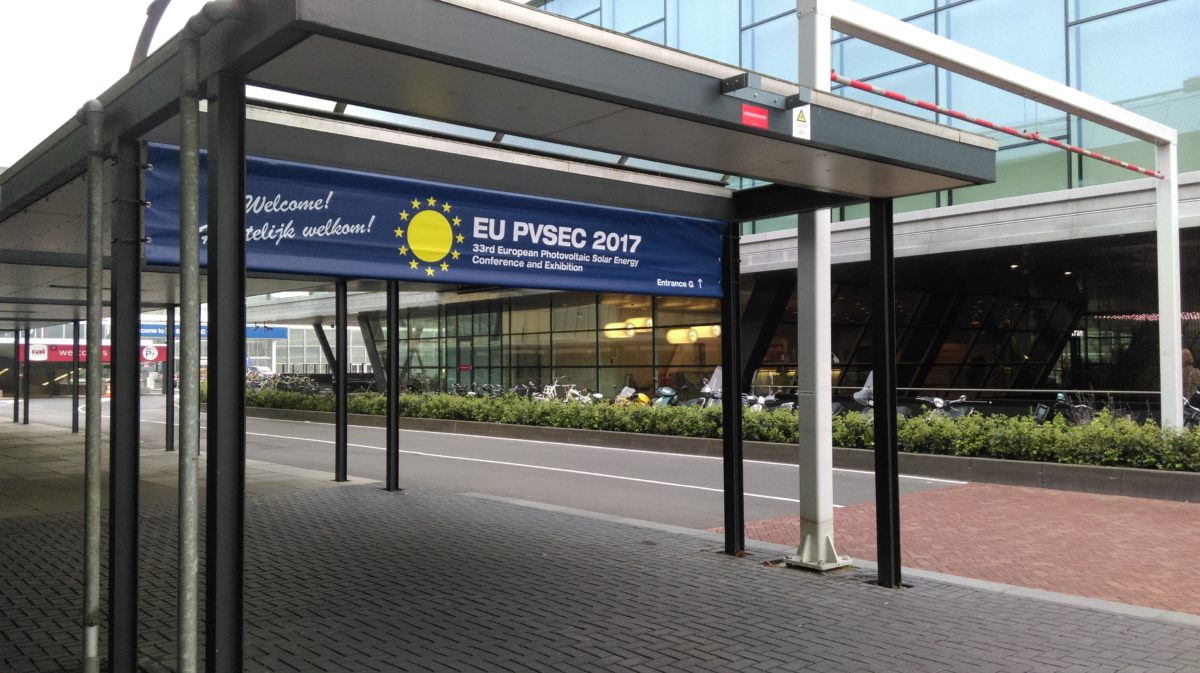Backsheets fulfill a multitude of tasks in ensuring module reliability. But generally, it is not possible to find the “right” material combination that can win in all categories. At PVSEC 2017, Isovoltaic and Bischof + Klein analyzed the advantages and disadvantages of their newly developed polyolefin (POE) backsheets and compared them with those that rely on polyester (PET), which today is the most widespread material.
Isovoltaic compared the tensile strength and elongation to break after stress was applied in a damp heat chamber. The tensile strength of co-extruded polyolefin (CPO) is almost constant, even after 10,000 hours in a damp heat test. PET is difficult to measure for such long periods of time, as the core material is too brittle to allow for damp heat tests longer than 3,500 hours, according to Isovoltaic.
Bischof + Klein, meanwhile, has tested the backsheet adhesion to EVA after damp heat testing. Its POE-based product, PP (Polypropylene), retains 43% of adhesion to EVA even after 4000 hours of damp heat testing, in comparison to three other different PET products, which lost almost 95% adhesion to EVA.
POE had further advantages in the transmissibility of acetic acids. Such acids are generated in decomposition reactions of EVA, which lies between the backsheet and the cells, and can cause corrosion inside the module. The higher the transmissibility, the lower the risk of damage due to these acids, Isovoltaic claims.
Another category in which POE-based backsheets have an advantage is with the reflection of light that doesn’t get absorbed when traveling through the cell. As this reflected light must pass through the cell again, thus being absorbed after reflection from inside the backsheet, the enhanced reflection helps to increase the yield. Isovoltaic refers to studies showing that this is responsible for 0.54% of absolute efficiency in standard modules. With POE it is possible to obtain 90% reflectivity, Isovoltaic said. Bischof + Klein also shows the higher reflectance in visible light in its tests, where reflectance can be adjusted using pigments and the base polymer.
Backsheets should be resistant to moisture ingression into the modules from the rear side, so the polymer should exhibit a good water vapor transmission rate (WVTR). According to both companies, the lowest WVTR value achieved for their individual products is 0.6 g/m2d, where PET products exhibit values almost two to three times that, with the BS thickness ranging from 340 to 380µm. However, PET-based backsheets do perform better in resistivity to abrasion and UV light, according to Isovoltaic.
One of the most important factors is the price. While Isovoltaic states that its new CPO concept offers a price advantage, it is generally a challenge for new technologies to compete with traditional products in this respect. And it is not easy to estimate the basis on which they evaluate the POE superiority over PET-based backsheet.
Furthermore, it is known that POE materials have limitations in terms of processing, as they have low melting points compared to other polymers. Therefore, they should not be processed at temperatures higher than 155°C (Bischof + Klein claims no more than 153°C). This restricts the lamination window for POE-based backsheet and the throughput due to the time-temperature correlation in the lamination process. And this is at a time in which it is important for manufacturers to develop faster processes.
The detailed article on backsheet and laminators technologies will be published in November issue.
This content is protected by copyright and may not be reused. If you want to cooperate with us and would like to reuse some of our content, please contact: editors@pv-magazine.com.








By submitting this form you agree to pv magazine using your data for the purposes of publishing your comment.
Your personal data will only be disclosed or otherwise transmitted to third parties for the purposes of spam filtering or if this is necessary for technical maintenance of the website. Any other transfer to third parties will not take place unless this is justified on the basis of applicable data protection regulations or if pv magazine is legally obliged to do so.
You may revoke this consent at any time with effect for the future, in which case your personal data will be deleted immediately. Otherwise, your data will be deleted if pv magazine has processed your request or the purpose of data storage is fulfilled.
Further information on data privacy can be found in our Data Protection Policy.